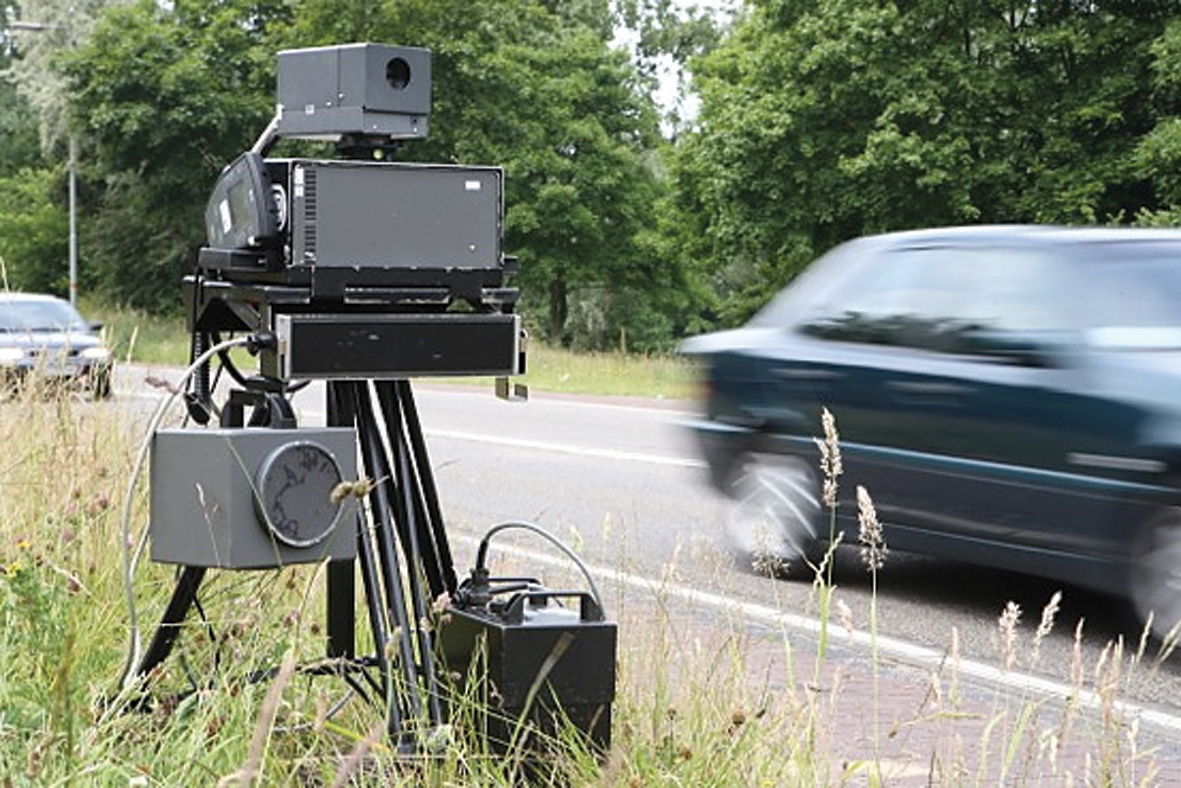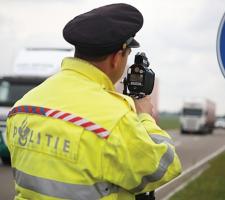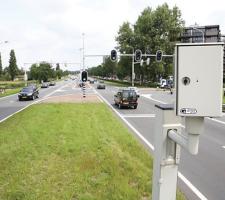
Mobile enforcement is used reduce speeding only after the road has been checked for compliance to established standards
While The Netherlands already has some of the safest roads in the world it has ambitious plans to make them safer still, as Jon Masters discovers.
In virtually all periodical studies and comparisons of countries’ road safety performance, the Netherlands is consistently in the top three and often leads the world, depending on how casualty figures are compared. According to the International Traffic Safety Data & Analysis Group (IRTAD) of the998 International Transport Forum, road deaths per capita have fallen 62% in the Netherlands since 1990. There were four fatalities per 100,000 Dutch inhabitants in 2011.
The Dutch government has set itself highly ambitious targets to reduce casualty and injury rates a lot further over the current decade. IRTAD’s 2013 annual report estimates that road traffic accidents are costing the Netherlands around €13 billion per annum, about 2.3% of GDP.
IRTAD’s latest report also says that the number of cyclists killed in the Netherlands increased by 20% in 2011, while fatalities among car occupants and motorised two-wheelers decreased by 6% and 10% respectively.
Speed is still a major problem on the Netherlands’ roads. Violations are rising on roads of 50km/h (31mph) and 80km/h (50mph) speed limits, according to IRTAD. On motorways a trend since 2005 has been an increasing V90 (speed below which 90% of motorists are driving), although the V90 on motorways with a 100km/h (62mph) speed limit has been decreasing.
Introduction of new road types has reduced speed limits on many Dutch roads. In urban areas, speed limits have been reduced from 50km/h to 30km/h. This lower limit now exists in at least 70% of urban areas in the Netherlands. A similar development has occurred on local roads. About 60% of roads in rural areas (not including state roads) have had their speed limits reduced from 80km/h to 60km/h, which has reduced driving speeds on these roads substantially, IRTAD’s report says.
Traffic enforcement efforts in the Netherlands are led by the country’s Public Prosecutor Ministry. Its main aims are to reduce fatalities and casualties in line with government targets of reducing road deaths to below 500 and serious injuries to 10,600 by 2020. In 2012, 650 people were killed on Dutch roads and 20,100 were seriously injured. The targets are set out in an underlying road safety plan that was first drawn up by the then Ministry of Transport in 2008. The Dutch government has pledged to re-evaluate the Road Safety Strategy 2008-2020 every four years. Its latest iteration was published in 2012, by the Netherlands’ Ministry of Infrastructure & Environment.
Traffic enforcement revolves around five priorities of helmets, seat belts, speed, red light adherence and alcohol. These areas of attention were identified by safety hazard research by the Netherlands’ SWOV Institute for Road Safety Research.
Special attention is also now being given to handheld phone use by drivers and cyclists, with an emphasis on local trends or characteristics of the problem, such as mobile phone use by agricultural traffic in rural areas.
According to IRTAD, it is not standard practice to collect data about the use of mobile phones in cars and their use prior to a crash in the Netherlands, which makes reliable determination of the number of crashes caused by phone use very difficult. However, data for 2008 indicates that about 50% of all Dutch car drivers use a mobile phone while driving at least once a week. In 2009, about 135,000 fines were issued for using a phone while driving.
The local emphasis of the Netherlands’ enforcement effort is fundamental. While the Public Prosecutor oversees and formulates objectives, the Netherlands’ police force – recently rationalised from 25 to 10 regional units – is responsible for translating the overarching objectives into enforcement plans.
National public prosecutor for traffic Pollyan Spoon says: “We have a number of agreements with the national police, which has special teams engaged with traffic enforcement throughout the country, working to plans devised to use their resources as effectively as possible.
“Everything is designed to maintain a focus on the most commonly violated rules and those locations and times of the day and week where road safety is most at stake. Speed is still a major problem, for which we are using a wide range of monitoring and enforcement methods. Think of laser and radar controls, speed cameras, section control systems or use of unobtrusive video cars.
“The formulated objectives for 2020 are obviously for the long term. Much shorter periods of consideration and immediate benefits apply to enforcement. For example, placing a speed camera has been shown to bring an immediate spike in road safety for that particular location.”
The Netherlands’ mix of traffic enforcement includes fixed sites and a variety of mobile techniques. As part of the strategy, combined speed and red light enforcement cameras are being installed at road junctions, under the country’s EG100 framework agreement, which will see more than 300 fixed installations throughout the country. Two discrete contracts were awarded to1679 Gatso earlier this year, for delivery, installation and maintenance of 94 and 143 of the company’s T-series cameras (see www.itsinternational.com). Overall, Spoon says, the Dutch government is focusing on the ‘three Es’ of engineering, enforcement and education to make roads safer. All are being employed to achieve as much behavioural change as possible, she says, with public communication of the reasons and aims behind enforcement.
“The government remains committed to road safety and is focusing on two target groups,” Spoon says. “To address a significant cause of road safety, people who behave aggressively in traffic are being specifically targeted, for example, requiring them to follow a behaviour course. Motorists who repeatedly drink and drive, get an alcohol interlock in their car.”
This device includes a built-in breathalyser and will only allow the vehicle’s ignition system to work if the driver gives a clear reading. Vulnerable road users, such as pedestrians, cyclists, children, the elderly and novice drivers make up the second target group.
“Trucks must now be equipped with larger and more effective mirrors to allow drivers to see cyclists right next to the vehicle. There is also particular attention paid to scooters and mopeds, motorcycles, single-vehicle accidents and safety on roads with 50km/h or 80km/h speed limits,” says Spoon.
With respect to enforcement, this comes into play where speed limits are frequently being exceeded or where a concentration of accidents is occurring, Spoon says. At such locations, the design of the road is considered first – whether or not this corresponds appropriately with the prevailing speed limit. If the road is found to be adequately furnished according to the established standards, then mobile controls such as laser or radar equipment will be used to attempt to reduce traffic speeds.
“If back comparison shows no improvement in offense rates and accidents, then that location becomes eligible for the placing of a speed camera. Radar checks are kept up on such dangerous roads and all controls are based on information from analysis of evidence,” Spoon says.
The Netherlands’ road safety strategy cuts across a lot of different organisations and its success hinges on cooperative targeted efforts. The Ministry of Infrastructure & Environment is coordinating with provinces, metropolitan regions, municipalities and regional road safety bodies.
“These are the organisations responsible for the safe design and operation of the roads they manage and maintain. They also provide information and traffic education. In addition, the government works closely with various social partners: Safe Traffic Netherlands, SWOV, the youth organisation Team Alert, cyclist groups, the481 ANWB [Royal Dutch Touring Club] and the partners in the Stay Safe Mobile programme,” says Spoon.
Enforcement in the Netherlands has been helped considerably by the 1992 Administrative Enforcement of Traffic Offences Act, also known as the ‘Mulder Law’. This deals with frequent relatively minor violations by administratively settling them out of court. For instance, the Mulder Law is used for offences such as exceeding the speed limit by less than 30 km/h on urban roads or less than 40 km/h on motorways. According to SWOV research, the Mulder Law has resulted quicker and more efficient settlement of traffic offences, with less demand on police and the courts.
This is due partly to the fact that liability in Mulder Law offences lies with the vehicle owner instead of the driver. This makes it possible to register offences using cameras alone and fine the registration number holder with the photographed number plate as evidence. It is possible to appeal, but the burden of proof lies with the holder of the vehicle registration number.
While the steps taken to enforce motoring legislation may appear to some as on the harsh side, the casualty figures prove they are effective.
In virtually all periodical studies and comparisons of countries’ road safety performance, the Netherlands is consistently in the top three and often leads the world, depending on how casualty figures are compared. According to the International Traffic Safety Data & Analysis Group (IRTAD) of the
The Dutch government has set itself highly ambitious targets to reduce casualty and injury rates a lot further over the current decade. IRTAD’s 2013 annual report estimates that road traffic accidents are costing the Netherlands around €13 billion per annum, about 2.3% of GDP.
IRTAD’s latest report also says that the number of cyclists killed in the Netherlands increased by 20% in 2011, while fatalities among car occupants and motorised two-wheelers decreased by 6% and 10% respectively.
Speed is still a major problem on the Netherlands’ roads. Violations are rising on roads of 50km/h (31mph) and 80km/h (50mph) speed limits, according to IRTAD. On motorways a trend since 2005 has been an increasing V90 (speed below which 90% of motorists are driving), although the V90 on motorways with a 100km/h (62mph) speed limit has been decreasing.
Introduction of new road types has reduced speed limits on many Dutch roads. In urban areas, speed limits have been reduced from 50km/h to 30km/h. This lower limit now exists in at least 70% of urban areas in the Netherlands. A similar development has occurred on local roads. About 60% of roads in rural areas (not including state roads) have had their speed limits reduced from 80km/h to 60km/h, which has reduced driving speeds on these roads substantially, IRTAD’s report says.
Traffic enforcement efforts in the Netherlands are led by the country’s Public Prosecutor Ministry. Its main aims are to reduce fatalities and casualties in line with government targets of reducing road deaths to below 500 and serious injuries to 10,600 by 2020. In 2012, 650 people were killed on Dutch roads and 20,100 were seriously injured. The targets are set out in an underlying road safety plan that was first drawn up by the then Ministry of Transport in 2008. The Dutch government has pledged to re-evaluate the Road Safety Strategy 2008-2020 every four years. Its latest iteration was published in 2012, by the Netherlands’ Ministry of Infrastructure & Environment.
Traffic enforcement revolves around five priorities of helmets, seat belts, speed, red light adherence and alcohol. These areas of attention were identified by safety hazard research by the Netherlands’ SWOV Institute for Road Safety Research.
Special attention is also now being given to handheld phone use by drivers and cyclists, with an emphasis on local trends or characteristics of the problem, such as mobile phone use by agricultural traffic in rural areas.
According to IRTAD, it is not standard practice to collect data about the use of mobile phones in cars and their use prior to a crash in the Netherlands, which makes reliable determination of the number of crashes caused by phone use very difficult. However, data for 2008 indicates that about 50% of all Dutch car drivers use a mobile phone while driving at least once a week. In 2009, about 135,000 fines were issued for using a phone while driving.
The local emphasis of the Netherlands’ enforcement effort is fundamental. While the Public Prosecutor oversees and formulates objectives, the Netherlands’ police force – recently rationalised from 25 to 10 regional units – is responsible for translating the overarching objectives into enforcement plans.
National public prosecutor for traffic Pollyan Spoon says: “We have a number of agreements with the national police, which has special teams engaged with traffic enforcement throughout the country, working to plans devised to use their resources as effectively as possible.
“Everything is designed to maintain a focus on the most commonly violated rules and those locations and times of the day and week where road safety is most at stake. Speed is still a major problem, for which we are using a wide range of monitoring and enforcement methods. Think of laser and radar controls, speed cameras, section control systems or use of unobtrusive video cars.
“The formulated objectives for 2020 are obviously for the long term. Much shorter periods of consideration and immediate benefits apply to enforcement. For example, placing a speed camera has been shown to bring an immediate spike in road safety for that particular location.”
The Netherlands’ mix of traffic enforcement includes fixed sites and a variety of mobile techniques. As part of the strategy, combined speed and red light enforcement cameras are being installed at road junctions, under the country’s EG100 framework agreement, which will see more than 300 fixed installations throughout the country. Two discrete contracts were awarded to
“The government remains committed to road safety and is focusing on two target groups,” Spoon says. “To address a significant cause of road safety, people who behave aggressively in traffic are being specifically targeted, for example, requiring them to follow a behaviour course. Motorists who repeatedly drink and drive, get an alcohol interlock in their car.”
This device includes a built-in breathalyser and will only allow the vehicle’s ignition system to work if the driver gives a clear reading. Vulnerable road users, such as pedestrians, cyclists, children, the elderly and novice drivers make up the second target group.
“Trucks must now be equipped with larger and more effective mirrors to allow drivers to see cyclists right next to the vehicle. There is also particular attention paid to scooters and mopeds, motorcycles, single-vehicle accidents and safety on roads with 50km/h or 80km/h speed limits,” says Spoon.
With respect to enforcement, this comes into play where speed limits are frequently being exceeded or where a concentration of accidents is occurring, Spoon says. At such locations, the design of the road is considered first – whether or not this corresponds appropriately with the prevailing speed limit. If the road is found to be adequately furnished according to the established standards, then mobile controls such as laser or radar equipment will be used to attempt to reduce traffic speeds.
“If back comparison shows no improvement in offense rates and accidents, then that location becomes eligible for the placing of a speed camera. Radar checks are kept up on such dangerous roads and all controls are based on information from analysis of evidence,” Spoon says.
The Netherlands’ road safety strategy cuts across a lot of different organisations and its success hinges on cooperative targeted efforts. The Ministry of Infrastructure & Environment is coordinating with provinces, metropolitan regions, municipalities and regional road safety bodies.
“These are the organisations responsible for the safe design and operation of the roads they manage and maintain. They also provide information and traffic education. In addition, the government works closely with various social partners: Safe Traffic Netherlands, SWOV, the youth organisation Team Alert, cyclist groups, the
Enforcement in the Netherlands has been helped considerably by the 1992 Administrative Enforcement of Traffic Offences Act, also known as the ‘Mulder Law’. This deals with frequent relatively minor violations by administratively settling them out of court. For instance, the Mulder Law is used for offences such as exceeding the speed limit by less than 30 km/h on urban roads or less than 40 km/h on motorways. According to SWOV research, the Mulder Law has resulted quicker and more efficient settlement of traffic offences, with less demand on police and the courts.
This is due partly to the fact that liability in Mulder Law offences lies with the vehicle owner instead of the driver. This makes it possible to register offences using cameras alone and fine the registration number holder with the photographed number plate as evidence. It is possible to appeal, but the burden of proof lies with the holder of the vehicle registration number.
While the steps taken to enforce motoring legislation may appear to some as on the harsh side, the casualty figures prove they are effective.














